Fukushima and Chernobyl, wind turbines and solar panels? Forget: the world is waiting for a nuclear energy renaissance
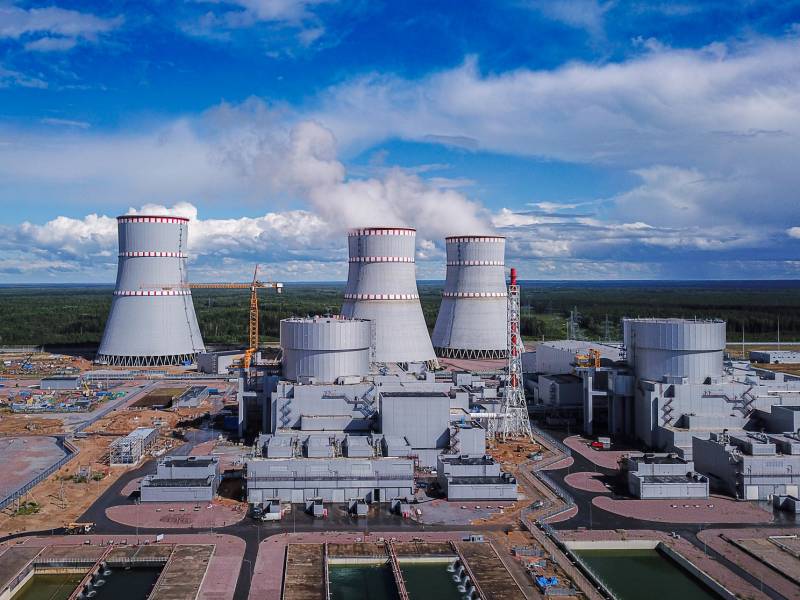
Nuclear energy was one of the greatest achievements of mankind: here too, Russia (USSR) was the first, having built the Obninsk nuclear power plant in 1954. The creation of a brilliant school of nuclear physicists, the best in the world, continues to allow us to maintain a leading position in this field. The role of nuclear power engineering (AE) in the contribution to modern development and advanced technologies is very high.
Global AE as a whole
Top 10 countries with operating nuclear power plants (2022)
The above diagram (statista.com) shows the status of the world leaders in nuclear energy (Word Nuclear Industry Status Report (WNISR), https://www.worldnuclearreport.org/World-Nuclear-Industry-Status-Report-2022-870.html).
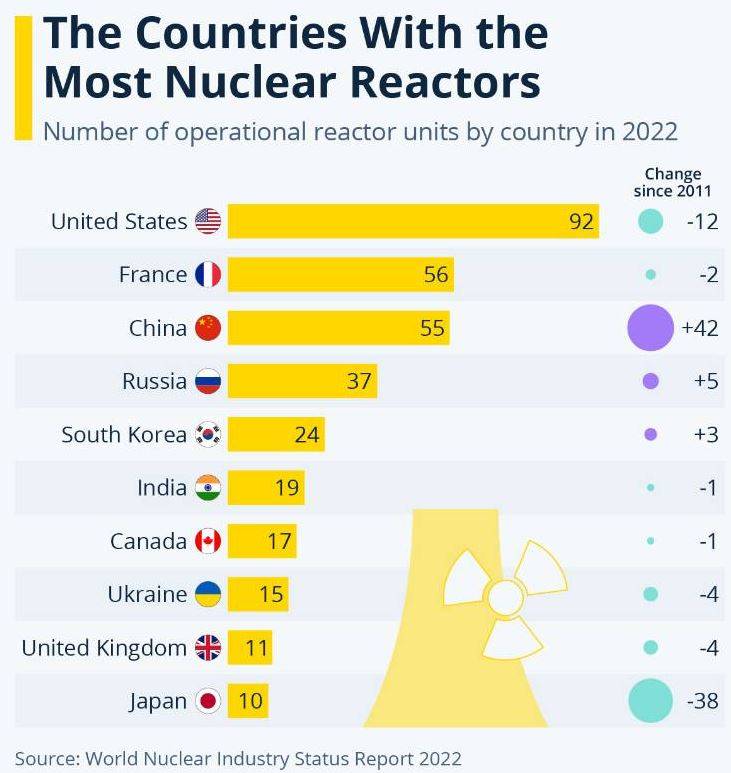
According to the WNISR for 2023 (World Nuclear Performance Report 2023), the total nuclear power in the world generated 2 TWh in 545, which is 2022% or 4 TWh less compared to 07 TWh in 108 .
Three events in Europe contributed greatly to this decline.
1. The nuclear power plant repair program in France led to a reduction in electricity generation by 81 TWh.
2. Closure of three of Germany's remaining six reactors at the end of 2021.
3. The SVO in Ukraine caused the shutdown of six units of the Zaporozhye NPP.
In 2022, the capacity of operating nuclear power plants at the end of the year amounted to 394 GW, which is 5 GW more than in 2021. The total number of operating reactors at the end of 2022 was 437, which is one more than in 2021. Just over 70% of all operating reactors are pressurized water reactors (PWR), including all those built since 2018. After a sharp drop in generation in 2012 due to the shutdown of units in Japan after the Fukushima accident, since 2013 the indicators have generally tended to grow cautiously (see graph).
Nuclear power's share of global electricity production fell to 2021 percent in 9,8, the first time below 10 percent, having peaked at 1996 percent in 17,5 and returning to 2022 percent in 10.

Main advantages and disadvantages of AE
The AE swot analysis is presented in the following table:
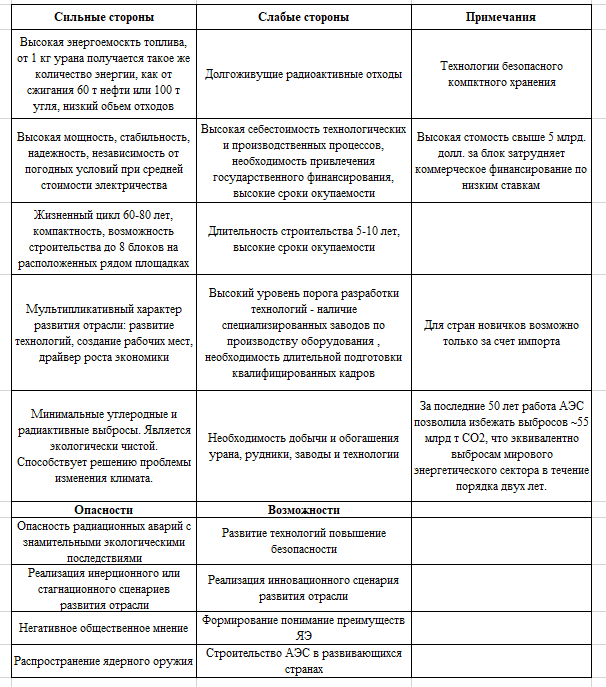
Investments in nuclear power plants are quite significant, but semi-fixed costs are not so high, and due to the huge service life, the economic indicators of nuclear power plants look excellent. A significant problem is the presence of highly radioactive waste, but safe and compact storage technologies have now been developed.
The main problem is radiation accidents, which can cause enormous damage. But both major accidents - both the Chernobyl nuclear power plant and Fukushima - lay in the plane of absolutely anomalous circumstances that caused them - and there are a lot of questions about them. But this is a separate topic. Accidents are different, some things can happen again, some things almost never happen. New reactor designs, including the VVER 1200, contain the highest possible protection against nuclear incidents.
Now the innovative development of nuclear power is on the way to increase the efficiency for VVR reactors, there are huge prospects in the direction of creating small and modular reactors that can be used for remote areas, military facilities, medium and small settlements. Of interest are works on fast neutron reactors (BN-1200, Beloyarsk NPP), including those with an innovative lead coolant (Brest project), attempts to create a so-called closed nuclear fuel cycle, as well as the use of MOX fuel.
In all these areas, Russia (Rosatom) is the world leader, as well as in the global industry as a whole. Due to the limited volume of the article, an overview of innovations, problems and risks in the AE will be in a separate article.
How did the fate of AE develop: euphoria, caution, stagnation
During the first period of development of the world AE, that is, before the accident at the Three Mile Island nuclear power plant (USA, 1979), there was a "euphoria" in relation to AE. It was thought to be an inexpensive, safe, and virtually limitless source of energy. From the mid-60s to the late 80s, the number of units built annually increased from 13 in 1969 to 43 in 1976. Although the accident had limited consequences, nuclear development programs in the United States were frozen.

But during this period, many specialists, including those in the USSR, lost their vigilance, naively believing that nuclear power plants were extremely safe production. The creators of the RBMK-1000 reactor (single-circuit boiling water reactor), who were at the Chernobyl NPP and a number of other nuclear power plants, wanted to supply about 100 units of this type to the USSR. And, according to Academician Alexandrov, the reactor was “so safe that it could even be placed on Red Square.”
After the accident at the Chernobyl nuclear power plant (USSR, Ukraine in 1986), the second stage began - "sobering up and caution", when the safety of nuclear power plants became the main problem hindering the rapid development of nuclear power. At operating "Chernobyl-type" nuclear power plants in Russia, a deep modernization of equipment was carried out. In the future, RBMK reactors began to be replaced by safer VVER-type nuclear power plants with a double circuit.
The accident at the Fukushima-1 nuclear power plant (Japan, 2011) led to the third stage in the development of the nuclear industry, which caused its actual collapse, freezing or reduction in generation. After an even higher risk assessment, many countries began to massively decommission old units of nuclear power plants, replacing them with gas-fired thermal power plants. The developers have tightened the safety requirements, complicating projects and increasing the cost and construction time. Along with this, the competitiveness of gas thermal power plants has increased with the introduction of a combined cycle cycle with a higher efficiency. Since 2006, the growth of electricity consumption has stopped in developed countries, which caused a drop in demand for an increase in electricity production.
Public opinion became even more suspicious of the use of AE. But those countries, primarily in the EU, that stopped their nuclear programs and focused on “clean energy” made huge mistakes, limiting their development and falling into an energy crisis, exacerbated by restricting Russian gas imports.
Italy, which had 4 nuclear power plants, was the first in the EU to abandon nuclear energy. In a referendum in 1987, the majority of the population opposed the nuclear power plant. Italy's last nuclear power plant was shut down in 1990. In 2008, the Berlusconi government, understanding the economic consequences of such a refusal, wanted to revive the nuclear program, but the referendum held in June 2011 (after the accident in Japan in March 2011) again gave a negative result.
Germany. The decision to abandon nuclear power was made in Germany in 2003, and in 2011 a ten-year plan for the development of "renewable energy" was adopted, which created the preconditions for the current crisis in Europe. Such a categorical decision was not entirely clear to politicians, experts and the public against the background of the energy crisis in the industrial power of Europe. The closure process accelerated after the Fukushima accident. Today, out of 17 existing power units, the last three nuclear power plants were turned off by the Germans in April 2023. But, according to opinion polls, about 2/3 of the Germans were in favor of continuing the operation of these stations.
A growing number of experts believe the vice-chancellor's plan to generate 2030% of the country's electricity from renewable sources by 80 is doomed to failure. For the above reasons, the expansion of wind energy in Germany has stalled, and the necessary energy storage facilities are missing.
The fight for reality continues. Belgium plans to phase out AE. Spain also, but discussion is possible. There is a fight going on in Switzerland. On June 20, 2023, the Swedish parliament decided, on the contrary, to abandon the predominance of green energy and return to nuclear power plants.
AE – international review: main trends
France is one of the leaders in nuclear energy in the world (No. 2) and No. 1 in Europe. Despite the skepticism of their neighbors, the French continued to develop this energy sector. As of January 1, 2023, there are 56 PWR reactors in operation with a total installed net capacity of 61 MW. France's operating reactor fleet accounts for 370% of the total number of reactors in Europe and 47,1% of the total installed gross capacity.
However, in 2022, the French nuclear industry experienced problems due to the maintenance of reactors, which was affected by the pandemic, as well as the need to combat corrosion and limit thermal discharges due to high heat. In early 2022, French President Emmanuel Macron announced the allocation of 51,7 billion euros to the French nuclear power recovery program.
In 2022, France, due to problems with nuclear power plants, lost about 14% of its electricity production. France is currently building only one block.
NPP "Flamanville"
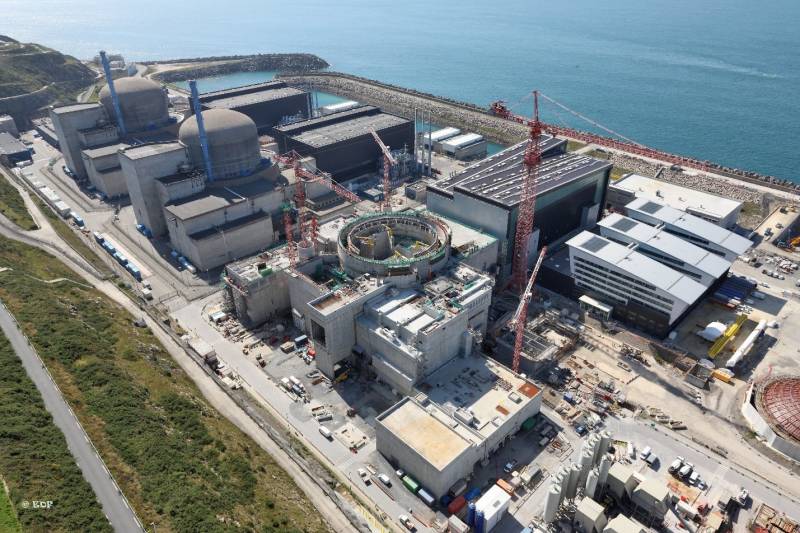
Since 2007, a new third-generation European reactor project EPR (European Pressurized Reactor) with a capacity of 3 MW has been under construction in France at the Flamanville-1 nuclear power plant site. This is a typical water-cooled double-circuit reactor (VVER) with increased power - 600 gigawatts (usually 1,6–1).
The reactor has a record thermal power of 4 megawatts and an electric power of 300 megawatts among all types of nuclear power plants, a turbine unit with a capacity of 1 megawatts with a low-speed turbine is a world power record. The power unit has a good efficiency - 600%, while the diameter of the reactor ~ 1 meters is only one meter larger than VVER-700.
As practice has shown, building an EPR is difficult, time-consuming and expensive. The Flamanville-3 project is a long-term construction project due to the discovery of defects and problems during construction. In April 2016, ASN announced that defects had been found in the reactor's steel, followed by the discovery of eight defective welds in the steam lines running through the reactor's double-wall containment vessel, and finally the recently announced need to replace the reactor pressure vessel cover.
The launch of the third power unit was planned for 2012, but due to numerous technical problems, it was postponed to 2016. In December 2022, EDF announced a new delay in the commissioning of the third block - for the first quarter of 2024. The project was expected to have an investment of around €3,3bn and be completed in four years, but the 2019 cost estimate was €13,2bn.
For the first time, the construction of the first unit based on the EPR-1600 reactor, belonging to generation III+, was started by the French company Areva in 2005 in Finland at the Olkiluoto nuclear power plant (see below). The first commissioning of a power unit of this type with increased power, EPR-1750, took place at the Chinese Taishan NPP. Currently, the British Hinkley Point C nuclear power plant is being built with their use at two units, the start of commercial operation of which is planned for 2026 and 2027.
Finland: Olkiluoto-3 power unit
In April 2023, the most powerful EPR-1600 reactor, the Olkiluoto-3 power unit, developed by the French, was launched in Finland. Construction began in 2005 and was supposed to be completed in 2009: the delay was 14 years! The new nuclear power plant generates 14% of Finland's total electricity consumption.

This is the most powerful block in Europe. A more powerful reactor is only available in China, the EPR‑1750 at the Taishan nuclear power plant. The reason for the “long-term construction” was numerous miscalculations and modifications by the designers and builders of the reactor. Electricity at the station is quite expensive, it cost 11 billion euros - 6 euros per kilowatt of power. Delays and cost overruns led to the bankruptcy of contractor Areva, which was saved from closure by the French government.
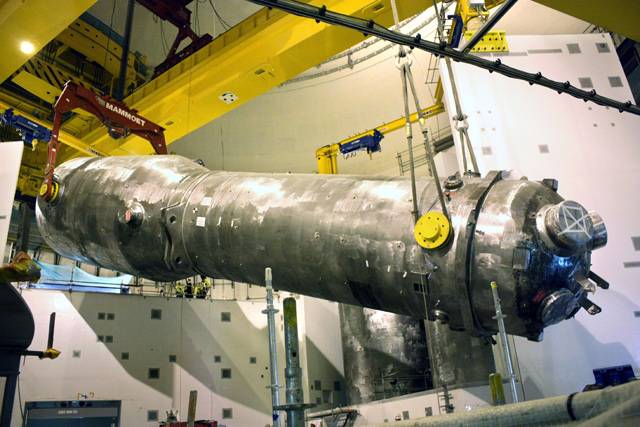
Steam generator installation
Previously, the Finns had a contract for the construction of a nuclear power plant at the Hanhikivi-1 site with Rosatom for the construction of a single-block nuclear power plant of the VVER-1200 generation 3+ project, with a capacity of 1 MW, the cost of which per kilowatt of power is three times less than the French reactor. The project was estimated at 200 billion euros. However, in 6,5, the Finnish design company Fennovoima terminated the contract with Rosatom. This is a completely political decision. Fennovoima demanded that Rosatom return the advance payment of 2022 million euros.
At the end of 2022, the International Dispute Resolution Council declared the termination of the contract by Finnish Fennovoima unlawful. Currently, JSC Atomenergoprom (part of Rosatom) has filed six claims against the Finns in international arbitration in the amount of about 3 billion euros, as well as a demand for early repayment of a loan of 920 million euros, which was issued by the Russian side to finance the construction of a nuclear power plant.
Europe against nuclear power plants: pros and cons
However, in Europe there is a group of countries, led by France and President Macron, who understand the prospects for the development of nuclear energy and have proposed including nuclear energy in the European Taxonomy (a classification system created to clarify which investments are environmentally sustainable, in the context of the European Green Deal) and recognition her green.
In October 2021, an article signed by 15 ministers from Bulgaria, Croatia, the Czech Republic, Finland, France, Hungary, Poland, Romania, Slovakia and Slovenia was published in the EU media. Her main theses are: “Nuclear energy is safe and innovative. For more than 60 years, the European nuclear industry has been proving its reliability and safety... Its development can create about a million highly qualified jobs in Europe...”
In response, in November 2021, 16 politicians from eight European countries, most notably Germany and Austria (which seem to be heavily influenced by the United States), turned to the European Commission (EC) demanding that nuclear energy not be included in the taxonomy of the European Union. "The future belongs to renewable energy sources," the politicians insisted. Obvious nonsense, given the actual energy crisis in the EU. In July 2022, AE was nevertheless included in the EU Taxonomy in an Additional Delegated Act.
France is also developing its foreign activities. In October 2021, EDF submitted a proposal to the Polish government for the construction of 4 to 6 EPR units. However, actual problems during construction in Finland caused Warsaw to refuse. South Korean or American companies will build nuclear power plants in Poland.
In April 2021, EDF submitted a feasibility proposal for the Jaitapur Nuclear Power Plant with six EPR reactors to NPCIL Nuclear Corporation of India. The deal is currently being agreed upon.
USA: they say one thing - they do another!
America has the most powerful, but the oldest nuclear power industry in the world, but as a result of the curtailment of the nuclear program, the country has seriously lagged behind in this industry. According to the IAEA (as of January 1, 2023), there are 92 reactors (54 nuclear power plants) in operation with a total net installed capacity of 94 MW.
In 2021, US nuclear power units generated 778 billion kWh, or 1,5% less than in 2020. The share of nuclear generation in the overall balance decreased and amounted to 18,9% compared to 19,7% in 2020.
Almost all operating NPPs were built in the period 1967–1990; new NPP projects were launched only in 2013. After the accident at the Three Mile Island nuclear power plant (1979), the crisis in the nuclear industry intensified, associated with the payback of nuclear power plants, competition with coal and gas stations. The planned construction was put on hold and no new stations were built. Only one new reactor has been launched in the last 26 years, and the nuclear power plant fleet continues to age, with an average age of 41,6 years, one of the oldest in the world. Construction continues only on the new AP-1000 nuclear power plant in the state of Georgia.

Palo Verde NPP (USA, Arizona), the largest nuclear power plant in the USA (3 power units of 1400 MW each)
While declaring a policy toward “clean” energy, the United States is not seeking to abandon nuclear power. The U.S. Department of Energy recently said it would invest billions in existing nuclear power plants over the next few years to support the U.S. drive to develop clean energy.
In fact, this means that America provides itself (for now) with an unconditional energy and, therefore, economic advantage over Europe, deliberately pushing it towards a crisis, which will be even more serious against the backdrop of the refusal of fuel and energy imports from Russia. At the same time, the US Energy Information Agency predicts a reduction in the nuclear fleet and the share of nuclear generation in the United States, since the small commissioning of new capacities does not fully replace the units being withdrawn.
Against this background, the US Department of Energy recently proposed to triple the capacity of nuclear power plants in the country, building 200 GW of new nuclear generation by 2050 to zero harmful emissions into the atmosphere. The program is estimated at over $700 billion. To achieve this goal, it is necessary to ensure the commissioning of 13 GW of nuclear power plants per year, launching them from 2030. However, according to experts, the United States is lagging behind in this industry, nuclear engineering and reactor building are poorly developed, fuel is not extracted and enriched, and the construction of such a volume of stations will require about $3 trillion. A "nuclear renaissance" in the US is also possible and quite in the "trend" (see EU). The program would have a huge multiplier effect on the entire US economy, and its adoption is likely.
China: world leader in nuclear energy development rates
As of mid-2022, China had 55 operating reactors with a total capacity of about 52 GW. In 2021, nuclear power plants produced 383,2 billion kWh in China, which is 5% of the country's electricity, almost the same as in 2020. China has the youngest nuclear industry. In March 2022, the National Energy Administration (NEA) published a plan that sets a goal of increasing the industry's installed capacity to 70 GW by 2025. However, this goal is most likely unattainable. As of 2022, China is building 21 units with a capacity of 20 MW.
In 2021, China began construction of three (Changjiang-3 and 4 and Sanaocun-2) new power units with Hualong One (Chinese Dragon) reactors, HPR-1000, 3rd generation pressurized water reactor project. The PRC plans to use this project as the basis for the development of its nuclear energy and export it.
Material on China's advanced nuclear projects will be discussed in a separate article on innovations in nuclear power.
Japan: before Fukushima and after
Before the accident at the Fukushima-1 nuclear power plant in March 2011, Japan’s nuclear power industry accounted for about 25–30% of the country’s electricity – it was a key link in the country’s development strategy “energy security – environmental protection – economic growth”. But a year after the disaster, this figure dropped to 2,7%, and in 2020 it was 4,3%.
After the accident, it was decided to decommission 27 operating reactors and stop the construction of three new ones. Measures were also taken to ensure safety in the event of natural disasters, regulation of the industry was significantly tightened, for which a new body was created - the Nuclear Regulation Authority (NRA). To protect against tsunamis, even higher and stronger sea outposts began to be built.
In August 2022, Japanese Prime Minister Fumio Kishida said he would restart idle nuclear power plants, marking a turnaround for the industry. The prime minister ordered a government panel to study the use of next-generation nuclear reactors equipped with new safety mechanisms to help Japan achieve its carbon neutrality goals by 2050. Therefore, a “nuclear renaissance” from Japan is also possible.
In 2021, the number of operating nuclear reactors in Japan has remained stable at just ten with a capacity of just under 10 GW. At the same time, for the period 2020-2021 there is an active growth from 43,1 TWh, which corresponds to a share of 5,1% in the total electricity balance, to 61,3 TWh (7,2%).
Russia is the undisputed leader in global nuclear energy
Currently, the Rosenergoatom Concern includes 11 operating nuclear power plants, 37 power units are in operation (including a floating power unit (FPU) of FNPP as part of 2 reactor units) with a total installed capacity of over 29,5 GW. In terms of production, we are in 4th place in the world. In 2022, Russian NPPs set a record for generation - 223,371 billion kWh.
Our country is the world leader in the construction of nuclear power plants abroad, occupying 70% of the world market for the construction of nuclear power plants. In 2021, the construction of 5 VVER-1200 units began at once: in China, India and Turkey. Russia is currently working on 10 nuclear power plant construction sites in the world.
According to the American magazine Power, the Russian power unit with a VVER-1200 reactor (unit No. 6 of the Novovoronezh NPP (No. 1 NVNPP-2)) of generation 3+ won the "Top Plants" nomination in 2017.
Power magazine notes: “The new VVER-1200 power unit at Novovoronezh NPP is based on the latest achievements and developments that all meet all safety requirements after Fukushima (which is why the power unit is considered a generation 3+ reactor). It is the first and only of its kind with a unique combination of active and passive safety features.”

NNPP
Rosatom now ranks second in the world in uranium production, extracting about 7 thousand tons per year (15% of the world market). In the first half of 2023, the United States bought 416 tons of uranium from Russia, which is 2,2 times more than in the same period in 2022, and the maximum since 2005; Russia meets 32% of America’s nuclear fuel needs.
According to White House nuclear adviser Pranay Vaddi, the United States is incurring costs due to excessive dependence on nuclear fuel from Russia, and therefore plans to increase production of enriched uranium at the Urenco plant in New Mexico.
Our country plans to further actively develop nuclear energy. Due to the vastness of the topic, the Russian nuclear program will be presented in a separate article.
Nuclear energy – a renaissance is just around the corner?
But windmills, solar panels and other sources of clean energy are fickle and unable to provide the required amount of power. This was confirmed by the energy crisis in Europe, exacerbated by the sanctions of the West, the main purpose of which is to untie the EU from Russia, increase dependence on the United States and remove an unnecessary competitor. The call was also the Texas crisis in the winter of 2021. A review on "clean energy" was published in the author's article on the VO "Clean Energy" as a geostrategy: will windmills and solar panels save the climate?
Modern nuclear technologies ensure efficient and safe power generation. There is no alternative to AE - if we talk about our latest developments VVER-1200, then they are: firstly, very reliable, and secondly, their emissions are clean.
In some countries with scarce fuel and energy and water resources, nuclear energy has no alternative. More and more countries are increasing their interest in nuclear energy. Thus, according to WNPR, as of mid-2022, 53 reactors were under construction in the world, including 21 in China, 8 in India, while in 2019 – 46; and in 2017 – 53.
According to the IAEA (as of January 1, 2023), of the 52 reactors currently under construction, 9 are located in newcomer countries. 28 countries are interested in nuclear power and have plans or are actively working to integrate it into their energy mix. An additional 24 Member States participate in Agency activities. Between 10 and 12 member states plan to commission nuclear power plants by 2030–2035.
However, the main problem is that the lowest construction costs exist mainly in Russia and China, which creates a demand for active exports of nuclear construction from Russia.
According to the International Energy Agency (IEA), since 2017, 87% of new nuclear reactors have been built or are being built according to Russian or Chinese designs. The former leaders have lost their positions in this direction, and it is not certain that they will be able to regain them.
For example, the electric capacity of each unit of the Turkish Akkuyu NPP will be 1200 MW, the total capacity will be 4 MW (800 units). The total cost of building a nuclear power plant is 4 billion US dollars, i.e. approximately 22 billion dollars per unit. Russia is building at its own expense. For comparison, at the Jaitapur NPP, six French reactors with a total capacity of 5,5 thousand MW were estimated by experts at 9,9 trillion rupees, more than $ 1 billion, France provides a loan for construction.
Another industry problem is aging reactors that have reached or are nearing their end of life. About 63% of the world's nuclear reactor power generating capacity is over thirty years old. Significant investments are required to maintain or extend the operation of such installations. And if funds are not allocated, the existing fleet of nuclear reactors in countries with developed economies could be reduced by 30%.
The head of the IEA believes that the world will not achieve the goal of climate neutrality by 2050 without AE, calls on the authorities and businesses of developed countries to change their attitude towards peaceful nuclear power.
According to The International Status and Outlook for Nuclear Energy 2021, there is growing global awareness that without access to affordable, reliable, sustainable and modern energy for all (United Nations Sustainable Development Goal (SDG) 7) achieve almost none of the other 16 SDGs, including ending all forms of poverty, hunger, tackling inequalities and addressing climate change.
According to the IAEA report for 2021, two scenarios are possible: in the optimistic scenario, the world nuclear power industry will double its capacity by the middle of the century; in the pessimistic scenario, it will remain at the same level of installed capacity as now, although its production will increase.
The report on achieving carbon neutrality (Net Zero by 2050, p. 57) indicates that to achieve this goal, global nuclear energy must double by 2050 - i.e., in essence, the IAEA’s optimistic scenario must be realized.
In a number of scenarios, nuclear energy plays a leading role; for example, Shell’s forecast shows the highest rate of nuclear energy growth – 7,8% per year. Also, relatively high growth rates of nuclear energy are shown in BP scenarios with increased energy consumption or accelerated decarbonization of the economy - 2,7% and 3%, respectively.
According to Alexander Novak, Deputy Chairman of the Government of the Russian Federation, many analysts are revising the forecasts for the development of nuclear power in the direction of increase. According to the latest IAEA estimates, by 2050 the installed capacity of nuclear power plants worldwide will grow to 873 GW, which is 10% more than the agency expected in last year's forecast. According to the IEA, by 2030 the generation of nuclear power plants in the world will increase by 16–22% and by 38–65% by 2050. The scenarios of the Intergovernmental Panel on Climate Change (IPCC) assume an increase in global nuclear power generation by 2–5 times by 2050. OPEC experts believe that in the period from 2021 to 2045, the share of nuclear power in the energy balance will increase from 5,3 to 6,6%.
Information